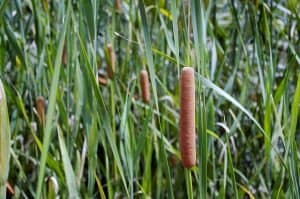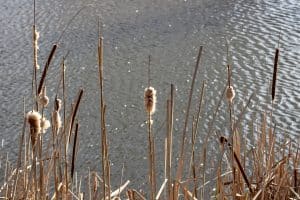What is Cattail Plant?
The cattail is an abundant plant in many parts of the United States. Cattail (genus Typha), a genus of about 30 species of tall marsh plants (family Typhaceae), found mainly in the temperate and cold regions of the northern and southern hemispheres. The plant grows in fresh or slightly rough water and is considered aquatic or semi-aquatic. Cattails are essential for wildlife, and many species are decorated as pond plants and dry flower arrangements.

Cattails are aquatic plants that are typically found in stagnant waters, especially at the edges of swimming pools, lakes, swamps, and coasts. The stem of the typhus plant grows 3 to 10 feet high below the water surface, producing a robust vertical stem and thin leaves. The “flower” is the famous part of the shape of a hot dog near the top of the stem. Inside the flower, there are thousands of seeds of light, dispersed by the wind.
Scientific Classification of Cattail Plant
Kingdom: Plantae
Clade: Tracheophytes
Order: Poales
Family: Typhaceae
Genus: Typha
How to Grow a Cattail plant?
If you have water gathering in your garden, like a pond or a swamp, cattails (Typha latifolia and T. Angustifolia) improve the eyes. Their sword-like brown leaves and inflorescences, which resemble cattails, have a unique architectural feature in the landscape. The “tails” of these plants provide nutrient-rich food for birds, bees, and other animals, as well as nesting materials.
From Seeds
Cattails are best grown from divisions, but will also grow reliably from seeds. The seeds germinate quickly in hot and humid conditions and will be ready for transplanting in a few months. Follow these steps to grow a cattail plant in your water garden.
- Collect the seeds in late summer when the brown sausage seed heads begin to dry out and dissolve. Snip the seed heads and put them in a large paper bag. Fold the sealed pouch and leave it in a warm, airy place for a week or two weeks to dry the seeds.
- Take the paper bag to a sheltered area with protection from the wind, such as inside the home. Take away the seed heads from the pack. Grip the end of the seed head and strip off the cottony seed matter into a bucket using your hand.
- Soak them for 24 hours, occasionally stir the water. Strain out the water the next day. Collect the dark brown thin seeds from the cotton seed material. Discard the cotton material. Rollout the seeds on a paper towel to dry them while you prepare the pots.
- Fill the pots 2 inches deep with a moist mixture of half made up of starter seeds and half coarse sand. Put two or three cattail seeds in each pot. Gentle press the seeds on the compost surface, then cover with a 1/4 inch thick layer of compost and sand.
- Place the pots on a within a cold frame. Set the temperature on about 100 Fahrenheit. Protect the pots with a clear plastic propagation dome to keep the heat from the germination mat around the seeds.
- Maintain the same level of humidity in the compost mixture. Water with a spray bottle instead of irrigation can limit seed ailments. Quickly the moisture level in the compost at least twice a day to make sure it doesn’t dry out completely.
- Watch the first signs of sprouting in two weeks. Remove the germination mat and the propagation dome after the buds appear then separate the cattail plants to one per pot. Keep both shoots stronger, more vigorous, and remove the weaker ones.
- Transplant cattail seedlings into individual 4-inch greenhouse pots filled with moist quickly drained soil. Grow them in partial shade for a month or two. Provide 1 to 2 inches of water every week. Slightly increase water if the weather is very hot and dry.
- Transplant cattails to a permanent location in early autumn, possibly after the first rain. Plant them 3 feet apart in consistently moist soil.

How to Care Cattail Plant?
Fertilizer
If the fish live in the pond or water garden where you are planting cattails, adding fertilizers is not suggested. Chemical fertilizers can destroy fish or make them sick, and the fish will provide a natural fertilizer to keep plants healthy. If there are no fishes in the pond or the water garden, slow-release tablets or granular fertilizers can be applied through the growing season. Select a fertilizer with a nitrogen-phosphorus-potassium (N-P-K) ratio of 5-10-5, 10-6-4 or 12-8-8, and use it at an amount of 4 ounces per 1 cubic foot of soil. Apply the tablet fertilizers directly to the ground or wrap the granular fertilizer in the coffee filter paper to make it easier to bury them in the submerged soil.
Control the Growth
Cattails spread antagonistically from seeds and underground roots. Growing in a pot water garden will control the spread of the roots, but the seeds can spread to nearby wetlands. If grown in a pond or stream, cattails can spread to fill the entire shoreline if their growth is left unchecked. To keep cattails confined to an area of the pond, new plants need to be removed regularly. Unsolicited cattails can be triggered when they reach 6 inches above the water surface. Make sure to remove the whole plant, including as many roots as possible. An alternative method of control is to cut new green shoots that come out of the water using sharp shears or gasoline shaving equipment.
Uses of Cattail Plant
There are some incredible uses of Cattail Plant from good taste to fashion uses:
- Every part of the cattail is edible throughout the seasons of the year. During the late fall and early winter, the roots can be harvested to make flour.
- The green leaves of cattail can be used to make shelter, Roofs made of these leaves are so strong that they can protect you from rain, wind or snow without losing any of their strength.
- This poultice from the root of the plant can be used for insect bites (spiders!), stings, scrapes, burns, and more. Burns can be treated with the fluff from the flowers and also useful for preventing diaper. Plus, young flowers can treat diarrhea.
- The dried leaves of the plant are also useful for fashion. You can use the fluff from the head of the plant to insulate jackets, coats, shoes, pants, and other clothing.
- The leaves are used for making strong rope and hand waved baskets.
Where can I buy Cattail Plants?
You can contact your local nurseries as well as local florists to buy cattail plants. You can also find cattail plants stem and seeds for sale in Amazon and Etsy.

Amelia is a plant and nature lover! Ever since she was little, she loved spending time in her family’s garden and learning about how to care for each plant individually. As an adult, she has dedicated herself to sharing what she has learned and continuing to expand her knowledge on the plant kingdom.

